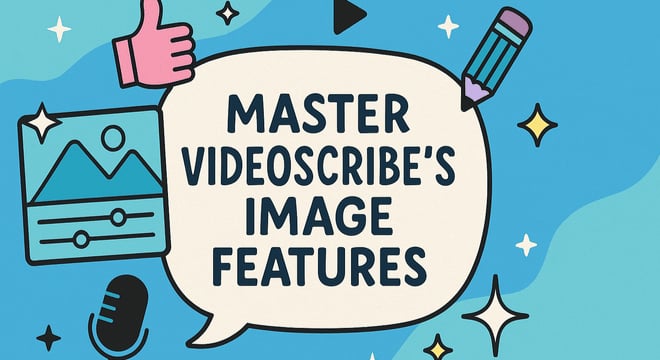As you build your project in VideoScribe for Browser, elements added to your project are displayed in the timeline. There are two timeline options you can choose from depending on your own preferences and needs: The simple and advanced timelines.
As part of our updates and improvements to VideoScribe for Browser, we introduced our Advanced Timeline feature. Our Advanced Timeline makes creating and editing your videos and animated GIFs more comprehensive and detailed than ever before!
While you still have the option to use the Simple Timeline to view and order your elements with ease, the advanced timeline gives you the option to edit your timings more closely, fine-tune all elements of your video, and navigate your project with a better eye for detail.
In this blog post, we will explain the basic functionality of both timelines so you can understand the differences and decide which one is right for you!
Before we share more tips and tricks on our timelines why not try it out for yourself with a 7-day VideoScribe Free Trial.
Basics of the Simple Timeline
The simple timeline is the default view and displays your elements as a series of tiles along the bottom of your editor:
- Elements will be animated in the order they appear on the timeline
- Numbers are displayed in the element tiles to indicate the animation order
- Element timings are displayed underneath each tile
- Drag and drop the element tiles along the timeline to change their order
- When you select an element in the timeline, you can edit the settings and animations in the right-hand panel

Basics of the Advanced Timeline
The advanced timeline is ideal for more detailed editing options. This includes more comprehensive editing for animation timings and audio. You can learn more about audio editing in our advanced timeline here.
How to get to the Advanced Timeline
You can view the Advanced Timeline by toggling the timeline switch at the bottom left corner of your project editing screen. You can also switch between the advanced and simple timelines at any time.
Navigating the Advanced Timeline
Within the timeline, each row represents one element, with the first element at the bottom and each subsequent element on the next line above. Element thumbnails are displayed on the left, and the various animation stages for each element can be identified by the animation icons in the row. Audio editing options such as voiceover and music tracks are displayed at the bottom of the timeline. Within the Advanced timeline, you can see the waveforms for your audio tracks which allow you to easily adjust the timings of your elements to synchronize with your voiceover and music.
Advanced Timeline Controls
Here is a quick guide to Advanced Timeline Controls. There are various controls surrounding the advanced timeline to adjust to your liking:
Left and right arrows: Use these arrows to jump to the beginning or the end of the timeline.
Expand arrows: Use this to reset to the default view.
Top slider: Use the ‘+ and -’ sliders to expand the timeline.
Left slider: Use the ‘+ and -’ slider to adjust the width and height of the animation blocks.
Scrollbars: Use the bottom and right scrollbars to scroll through your timeline.

And there you have it! Now you know the differences between our advanced and simple timelines and how to use them.
For more information and help on our timelines and how to use them you can visit our helpsite or take a look at our advanced timeline features in action in the video below.
Have you tried both timelines in VideoScribe for Browser? Which timeline do you prefer? Let us know on Twitter, Facebook or on our community page.


.png)



![How to create animation magic [3-part guide to video success]](https://blog.videoscribe.co/hubfs/How%20to%20create%20animation%20magic%20guide%20VideoScribe.png)


.png)


COMMENTS